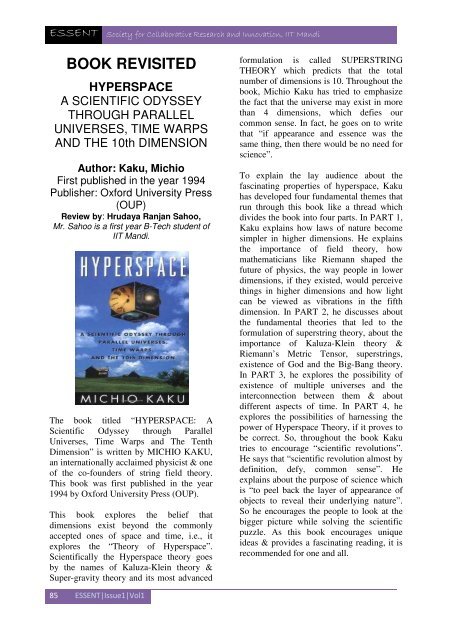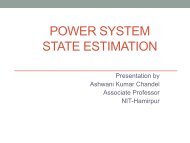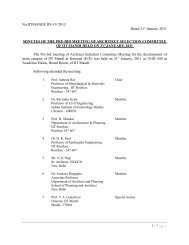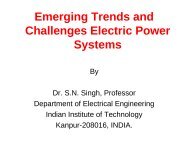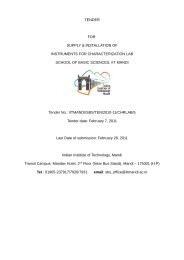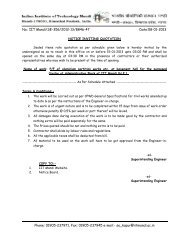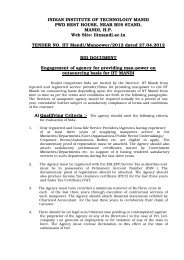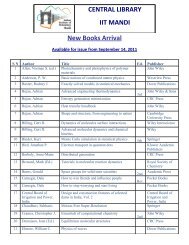Issue1. Vol.1 (April, 2013) - IIT Mandi
Issue1. Vol.1 (April, 2013) - IIT Mandi
Issue1. Vol.1 (April, 2013) - IIT Mandi
- No tags were found...
You also want an ePaper? Increase the reach of your titles
YUMPU automatically turns print PDFs into web optimized ePapers that Google loves.
ESSENT Society for Collaborative Research and Innovation, <strong>IIT</strong> <strong>Mandi</strong>BOOK REVISITEDHYPERSPACEA SCIENTIFIC ODYSSEYTHROUGH PARALLELUNIVERSES, TIME WARPSAND THE 10th DIMENSIONAuthor: Kaku, MichioFirst published in the year 1994Publisher: Oxford University Press(OUP)Review by: Hrudaya Ranjan Sahoo,Mr. Sahoo is a first year B-Tech student of<strong>IIT</strong> <strong>Mandi</strong>.The book titled “HYPERSPACE: AScientific Odyssey through ParallelUniverses, Time Warps and The TenthDimension” is written by MICHIO KAKU,an internationally acclaimed physicist & oneof the co-founders of string field theory.This book was first published in the year1994 by Oxford University Press (OUP).This book explores the belief thatdimensions exist beyond the commonlyaccepted ones of space and time, i.e., itexplores the “Theory of Hyperspace”.Scientifically the Hyperspace theory goesby the names of Kaluza-Klein theory &Super-gravity theory and its most advancedformulation is called SUPERSTRINGTHEORY which predicts that the totalnumber of dimensions is 10. Throughout thebook, Michio Kaku has tried to emphasizethe fact that the universe may exist in morethan 4 dimensions, which defies ourcommon sense. In fact, he goes on to writethat “if appearance and essence was thesame thing, then there would be no need forscience”.To explain the lay audience about thefascinating properties of hyperspace, Kakuhas developed four fundamental themes thatrun through this book like a thread whichdivides the book into four parts. In PART 1,Kaku explains how laws of nature becomesimpler in higher dimensions. He explainsthe importance of field theory, howmathematicians like Riemann shaped thefuture of physics, the way people in lowerdimensions, if they existed, would perceivethings in higher dimensions and how lightcan be viewed as vibrations in the fifthdimension. In PART 2, he discusses aboutthe fundamental theories that led to theformulation of superstring theory, about theimportance of Kaluza-Klein theory &Riemann’s Metric Tensor, superstrings,existence of God and the Big-Bang theory.In PART 3, he explores the possibility ofexistence of multiple universes and theinterconnection between them & aboutdifferent aspects of time. In PART 4, heexplores the possibilities of harnessing thepower of Hyperspace Theory, if it proves tobe correct. So, throughout the book Kakutries to encourage “scientific revolutions”.He says that “scientific revolution almost bydefinition, defy, common sense”. Heexplains about the purpose of science whichis “to peel back the layer of appearance ofobjects to reveal their underlying nature”.So he encourages the people to look at thebigger picture while solving the scientificpuzzle. As this book encourages uniqueideas & provides a fascinating reading, it isrecommended for one and all.85 ESSENT|Issue1|Vol1


